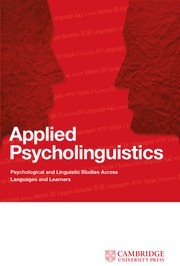Article contents
Rhyme and analogy in beginning reading: Conceptual and methodological issues
Published online by Cambridge University Press: 01 March 2000
Abstract
Goswami and Bryant (1990) proposed a theory of reading development based on three causalconnections. One of these causal connections was based on the relationship between rhymingskills and reading development found in English. To explain this connection, they suggested thatyoung readers of English used analogies based on rimes as one means of deciphering thealphabetic code. This proposal has recently become the subject of some debate. The most seriouscritique has been advanced by Seymour and his colleagues (Duncan, Seymour, & Hill,1997; Seymour & Duncan, 1997; Seymour & Evans, 1994). These authors reported aseries of studies with Scottish schoolchildren which, they claim, show that progression in normalreading acquisition is from a small unit (phonemic) approach in the initial stage to a large unit(rime-based) approach at a later stage. Two experiments are presented which replicate thoseconducted by Seymour and his group with samples of English schoolchildren. Different resultsare found. It is argued that methodological and instructional factors may be very important forthe conceptual interpretation of studies attempting to pit “small” units (phonemes)against “large” units (onsets and rimes) in reading. In particular, it is necessary toconsider whether a given phonological awareness task requires the recognition of sharedphonological segments (“epilinguistic” processing) or the identification andproduction of shared phonological segments (metalinguistic processing). It is also important totake into account the nature of the literacy instruction being implemented in participatingschools. If the phonological aspects of this tuition focus solely on phonemes (small units), thenpoor rime-level (large unit) performance may be found in metalinguistic tasks.
Information
- Type
- Research Article
- Information
- Copyright
- © 2000 Cambridge University Press
- 53
- Cited by

